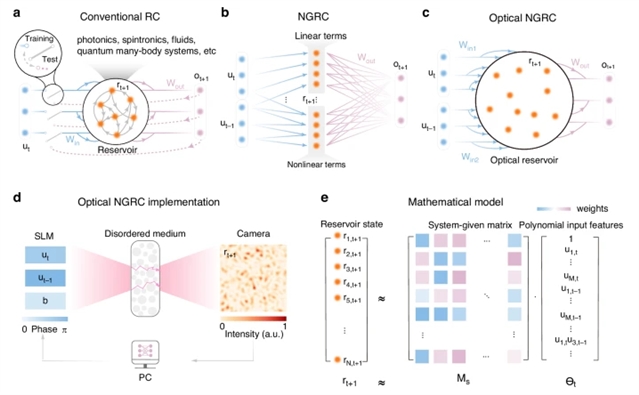
近日,清华大学刘强团队研究了光学下一代储层计算。相关论文于2025年7月21日发表在《光:科学与应用》杂志上。
具有内动态的人工神经网络在信息处理方面表现出非凡的能力。储层计算(RC)是一个典型的例子,它具有丰富的计算表现力和与物理实现的兼容性,从而提高了效率。最近,一种新的RC范式被称为下一代油藏计算(NGRC),它进一步提高了表达能力,但损害了其物理开放性,给物理系统的实现带来了挑战。
研究组演示了光学NGRC的计算通过光散射通过无序介质。与传统的光学RC实现相比,他们直接且单独地使用延时输入驱动其光库。就像数字NGRC依赖于延迟输入的多项式特征一样,它们的光学储层也隐式地为所需的功能生成这些多项式特征。
通过利用储层输入的领域知识,研究组发现光学NGRC不仅可以预测低维Lorenz63和大尺度Kuramoto-Sivashinsky混沌时间序列的短期动力学,而且可以复制它们的长期遍历性质。与基于散射介质的传统光学RC相比,光学NGRC具有训练时间短、超参数少的优势,同时具有更好的预测性能。他们的光学NGRC框架可能会激发NGRC在其他物理RC系统中的实现,超越时间序列处理的新应用,以及深度和并行架构的广泛发展。
附:英文原文
Title: Optical next generation reservoir computing
Author: Wang, Hao, Hu, Jianqi, Baek, YoonSeok, Tsuchiyama, Kohei, Joly, Malo, Liu, Qiang, Gigan, Sylvain
Issue&Volume: 2025-07-21
Abstract: Artificial neural networks with internal dynamics exhibit remarkable capability in processing information. Reservoir computing (RC) is a canonical example that features rich computing expressivity and compatibility with physical implementations for enhanced efficiency. Recently, a new RC paradigm known as next generation reservoir computing (NGRC) further improves expressivity but compromises its physical openness, posing challenges for realizations in physical systems. Here we demonstrate optical NGRC with computations performed by light scattering through disordered media. In contrast to conventional optical RC implementations, we directly and solely drive our optical reservoir with time-delayed inputs. Much like digital NGRC that relies on polynomial features of delayed inputs, our optical reservoir also implicitly generates these polynomial features for desired functionalities. By leveraging the domain knowledge of the reservoir inputs, we show that the optical NGRC not only predicts the short-term dynamics of the low-dimensional Lorenz63 and large-scale Kuramoto-Sivashinsky chaotic time series, but also replicates their long-term ergodic properties. Optical NGRC shows superiority in shorter training length and fewer hyperparameters compared to conventional optical RC based on scattering media, while achieving better forecasting performance. Our optical NGRC framework may inspire the realization of NGRC in other physical RC systems, new applications beyond time-series processing, and the development of deep and parallel architectures broadly.
DOI: 10.1038/s41377-025-01927-6
Source: https://www.nature.com/articles/s41377-025-01927-6
Light: Science & Applications:《光:科学与应用》,创刊于2012年。隶属于施普林格·自然出版集团,最新IF:19.4
官方网址:https://www.nature.com/lsa/
投稿链接:https://mts-lsa.nature.com/cgi-bin/main.plex
